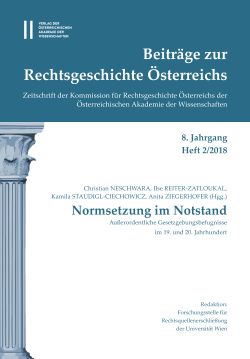
Beiträge zur Rechtsgeschichte Österreichs 2 / 2018, pp. 318-343, 2018/11/28
Normsetzung im Notstand
Außerordentliche Gesetzgebungsbefugnisse im 19. und 20. Jahrhundert
After World War I the Republic of Austria faced a total state bankruptcy. Further loans, guaranteed by several European states, required an intense reform program involving the League of Nations. The realisation of this program by regular parliamentary legislation seemed dubious. Therefore, a special institution was created – the ‘Extraordinary Cabinet Council’, which constitutional history regards as an institution between legislation and administration. This paper describes how this ‘Extraordinary Cabinet Council’ was conceived and set up, which aims it should have served and (based on the protocols in the Austrian State Archives) how it actually worked. On the whole, the ‘Extraordinary Cabinet Council’ points to the distrust in democratic institutions in the interwar period – even in democratic states.
Keywords: administration–Austria, democracy–Extraordinary Cabinet Council–Extraordinary legislation–Geneva Protocols–state bankruptcy